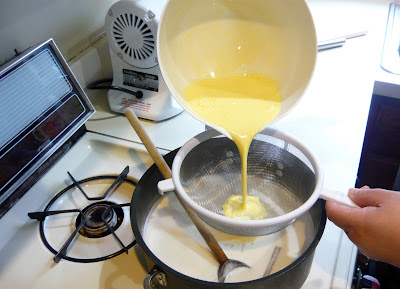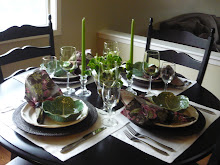When I was growing up, I watched my mother make Natilla all the time. My brother, Al, and I would stand by the stove waiting for her to finish so we could scrape the pot clean. I'll be darned if history hasn't repeated itself! This is one of my kids' favorite desserts, and, sure enough, even now, they will wait by the stove until I finish making it, anxiously hoping that I'll leave some in the pot, so they can have a little taste right away.
It took me a while to learn how to make this, since my mother never wrote down the recipe. She learned to cook using the metric system, so when I'd ask her how many cups, she'd say: “I don't know, about a liter . . . ” Argh! And figuring out the correct amount of corn starch took many, many tries. But I eventually got it just right, and it's become one of our family's comfort foods. Here's the recipe:
Add 4 cups of whole milk to a sauce pan or Dutch Oven. I use my Calphalon Dutch Oven all the time and love its versatility!
Another cup of milk goes in a mixing bowl . . .
Add a cup of sugar to the milk in the pot . . .
Add a cinnamon stick and a tablespoon vanilla extract . . . more or less . . . Cook over medium heat, stirring until sugar is dissolved.
Add a pinch of salt . . . about ½ teaspoon . . .
While the milk is heating, separate 5 eggs . . .
Beat the egg yolks with a fork until combined, then add to the milk in the mixing bowl . . . Save the egg whites for an omelette, or for making meringues . . .
Add ½ cup corn starch to mixture in the bowl . . . Mix ingredients with a fork or whip until most of the lumps from the corn starch are dissolved . . .
By now, the milk should be just about ready to boil. The top should look a bit frothy . . .
Add the mixture in the mixing bowl to the pan, straining it through a sieve to catch any undissolved lumps . . .
Stir gently, but continuously with a whip to avoid lumps. A silicone whip won't scratch the non-stick pot . . .
The custard will thicken quickly, as if by magic . . .
Ladle onto ramekins and sprinkle with ground cinnamon. Serve chilled.
I make Natilla so frequently that I've acquired a ramekin wardrobe over the years to change the presentation of this delicious, but simple dessert. Here it is in BIA Cordon Bleu ramekins . . .
In clay ramekins . . .
In squash-shaped ramekins for Halloween . . .
In Picardie juice glasses . . .
In small pedestal bowls for our mini-dessert table last Christmas . . .
It can be made ahead for a party, covering each individual ramekin with plastic wrap. I've used this recipe as the custard in English Trifle. Serve it with fresh strawberries. Serve it with lady fingers. Serve it fast! This won't stay in your refrigerator for very long.




































































